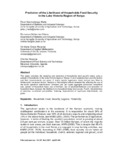Prediction of the Likelihood of Households Food Security in the Lake Victoria Region of Kenya
| dc.contributor.author | Mwita, Peter N. | |
| dc.contributor.author | Otieno, Romanus Odhiambo | |
| dc.contributor.author | Masanja, Verdiana Grace | |
| dc.contributor.author | Muyanja, Charles | |
| dc.date.accessioned | 2019-08-16T08:12:13Z | |
| dc.date.available | 2019-08-16T08:12:13Z | |
| dc.date.issued | 2011 | |
| dc.identifier.uri | http://ir.mksu.ac.ke/handle/123456780/4736 | |
| dc.description.abstract | This paper considers the modeling and prediction of households food security status using a sample of households in the Lake Victoria region of Kenya. A priori expected food security factors and their measurements are given. A binary logistic regression model derived was fitted to thirteen priori expected factors. Analysis of the marginal effects revealed that effecting the use of the seven significant determinants: farmland size, per capita aggregate production, household size, gender of household head, use of fertilizer, use of pesticide/herbicide and education of household head, increase the likelihood of a household being food secure. Finally, interpretations of predicted conditional probabilities, following improvement of significant determinants, are given | en_US |
| dc.language.iso | en_US | en_US |
| dc.subject | Household | en_US |
| dc.subject | Food | en_US |
| dc.subject | Security | en_US |
| dc.subject | Logistic | en_US |
| dc.subject | Probability. | en_US |
| dc.title | Prediction of the Likelihood of Households Food Security in the Lake Victoria Region of Kenya | en_US |
| dc.type | Article | en_US |
Files in this item
This item appears in the following Collection(s)
-
School of Pure and Applied Sciences [259]
Scholarly Articles by Faculty & Students in the School of Pure and Applied Sciences

